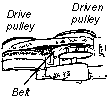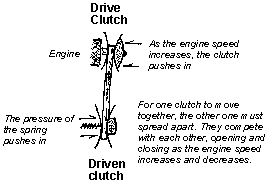|
Standards
A 6,
15
B 1, 3
D 1, 3
|
|
Concepts
Friction
Inertia
Mechanical
advantage
|
|
Snowmachine clutches are a genius of invention. They do so much
so simply.
All engines attempt to match the engine speed to the load on the
engine.
- Trucks, cars, and most four-wheel ATVs have to shift gears
as they accelerate and decelerate.
- An outboard motor has only forward, neutral, and reverse. The
pilot of an outboard motor must change props in order to “change
gears” from a work prop to a speed prop.
- Some airplanes can change the pitch of the prop as they fly.
Others have a fixed prop.
- A chainsaw clutch is like a one speed transmission. The chain
is either stopped or it is turning at the same speed as the engine.
None of these compare to a snowmachine clutch which is constantly
sensitive to the load and force generated by the engine, balancing
them in a constant flow of mechanical advantage. It is truly a beautiful
thing to watch. A few models of four-wheel ATVs use the same type
of clutch.
 Pulleys
of Different or Same Size Pulleys
of Different or Same Size
- If two pulleys of the same size are connected by a belt, as
one turns, the second one will turn at the same speed with the
same power available at the shaft.
- If a smaller pulley turns a larger one, the larger one will
turn slower, but with more power available at the shaft.
- If a bigger pulley turns a smaller one, the smaller one will
turn much faster than the bigger one but with less power available
at the shaft.
|
|
|
Example of Shifting a Truck
In low gear, a truck engine turns fast, but the wheels turn slowly.
The truck goes slowly, but with power.
In higher gears, the engine turns more slowly, but the wheels
are turning fast. There is less power to accelerate in higher gears,
but the speed of the truck is much greater.
|
|
|
Effect of Load on an Engine
Overload
If an engine is overloaded, the speed of the engine (rpm1) is
reduced, and there is tremendous stress on all of the drive components.
Underload
If an engine doesn’t have enough load, it can turn so fast
(high rpm) that it can self destruct. The inertia of the piston
going up and down at a speed too great for the engine will stress
all of the internal parts.
Conclusion
The load on the engine governs the speed of the engine.
For an engine to run efficiently, it must be balanced with the
load. We wouldn’t try to go 60 mph down the highway with a
truck in first gear, nor would we try to start the truck in fourth
gear.
|

|
 Parts Parts
A snowmachine clutch is made of two pulleys and a wide belt:
- The drive pulley is on the end of the engine crankshaft.
- The driven pulley drives the chain that connects to the track.
- The belt connecting the two pulleys is strong enough to transmit
the energy of the engine to the track. It has enough friction
with both pulleys that it won’t slip, except in extraordinary
circumstances (as occurs when the track is frozen down.) The belt
must be extremely strong yet flexible, even in very cold temperatures.
|
Description of Low and High
Gear
- When the snowmachine is starting to move, the engine is turning
rather fast, but the track is turning slowly. There is ample power
to get the machine going.
- When the machine is accelerating, the engine speed is reducing
and the track speed is increasing.
- When the machine is at a cruising speed, the engine slows down
and the track turns quickly.
The size of the drive and driven pulleys change while the machine
is running.
Idling
When the machine is stopped, the engine turns, but the belt and
track do not. The drive pulley is spread apart.
 Starting Starting
When the engine is accelerated, the drive pulley closes together
pinching the belt, connecting the engine to the track. The machine
moves forward, with the drive pulley small, and the driven pulley
large. The machine’s speed is low, but the torque is high.
This is like low gear in a truck.
Accelerating
As the machine accelerates, the engine speed increases, and the
drive pulley closes together, making the drive pulley bigger. This
spreads the driven pulley, making it a smaller pulley. At this point
the drive and driven pulleys might be the same size. This is like
second gear in a truck.
Cruising
When the machine is at cruise speed, the drive pulley is closed
together, making it a large pulley. The driven pulley is spread
apart, making it a smaller pulley. This is like high gear in a truck.
The track is going fast, but the engine is not. This speed is more
fuel efficient with less wear and vibration. The larger drive pulley
is driving the smaller driven pulley.
Decelerating
As the machine encounters resistance, whether it is a hill or
soft trail, the engine is slowed by the load against it. The drive
pulley slows down, and spreads apart. The driven clutch is then
driven together by its springs. This is like downshifting to a lower
gear in a truck. The engine speed increases and the track speed
is reduced, giving more power for the machine to work against the
resistance.
We might ask why cars and trucks don’t have this kind of
transmission if it is so good. The belt system isn’t strong
enough or efficient enough for large engines and large loads.
|
|
|
 The
Drive Clutch Responds to the Load on the Engine The
Drive Clutch Responds to the Load on the Engine
The drive pulley has weights that move out when the engine speed
increases. They force the movable half of the drive clutch towards
the other half, making it, in effect, a larger pulley.
When a load is encountered, the engine speed drops, and the springs
within the clutch push it apart, in effect making it a smaller pulley.
The force of the weights in the drive clutch balance with the
force of the springs in both the drive and driven clutches. Those
forces flow against each other, constantly keeping the load and
force of the engine in balance. Block up the rear end of a snowmachine,
and observe the clutch working as the track spins above the ground.
|
|
|
Maintenance
There is a beautiful balance between the pressure of the springs
and the force of the weights in the drive clutch. If any of the
parts are not well lubricated, that balance will be hindered.
It is important to use polar grease that will not get too thick
in very cold weather. The clutch should be sensitive to load, and
not be sensitive to temperature.
Adjusting the clutch
Most machines have a way to tighten or loosen the spring of the
driven clutch. Stronger or weaker springs can be installed.
If the spring in the driven clutch is too strong, it resists spreading.
In effect, it gives the machine more power, but causes the engine
to operate at a higher rpm than is healthy. If the spring is too
weak, the driven clutch spreads easily. Top speed is easily reached,
but the engine stresses and is weak in acceleration.
|

|
Activities
- Remove the clutch guard from a machine and identify the parts.
- Block the back of the machine up or suspend it so the track
is free from the ground. With students at a safe distance, start
the engine. Accelerate and decelerate the engine. Can you see
the clutch responding automatically to the throttle changes?
- Watch the drive clutch. Is it bigger at low or high rpm?
- Watch the driven clutch. Is it bigger at low or high rpm?
- Is clutch movement smooth or erratic? If it is not smooth,
what does this indicate?
- At below zero temperatures, put polar grease between your fingers
on one hand and regular grease between the fingers of the other
hand. Can you feel the difference?
- What would slip if the track were frozen down and the engine
accelerated? Do you see evidence of this around the clutch?
- Remove and replace a drive belt. Compare a worn and a new belt
for width. Find the price of a new belt.
- Can you see the weights in the drive clutch? If this isn’t
possible, try to find an old one that has been taken apart. Describe
how centrifugal force causes the drive clutch to close together.
Draw what you imagine happening.
- Compress the spring from both the drive and driven pulleys.
Are they stronger or weaker than you thought? Is there a way to
tighten the spring on the driven pulley on the machine you are
looking at?
- Improvise some pulleys, even if you have to use a rubber band
as a drive belt. Use different size thread spools as pulleys if
you can’t find anything else. Predict how many turns the
driven spool will turn when the drive spool turns once.
- Drive a four-wheel ATV, accelerating through the gears. While
doing this, try to imagine what would be happening to the drive
and driven pulleys if it had a snowmachine clutch. (Actually,
Polaris six-wheelers have a clutch like a snowmachine.)
- Do you think this kind of clutch would work on an outboard
motor, giving better performance?
|

|
Student Response
- How do each of the following attempt to balance the engine
speed with the load?
- Trucks, cars, & four wheelers
- Outboard motors
- Airplanes
- What are the three main parts of a snowmachine clutch?
- Which clutch is on the end of the engine’s driveshaft?
- Draw a picture of a big pulley driving a smaller one. If the
big pulley turns once, will the little one turn more or less than
one turn?
- Draw a picture of a smaller pulley driving a bigger one.
- Draw a picture of two pulleys of the same size.
- Which of the above pictures illustrates an engine starting
to move?
- Which one of the above illustrates an engine at cruise speed?
- What is the main advantage of a snowmachine clutch over a truck
transmission?
- Why couldn’t a snowmachine clutch be used on a truck or
car?
- What is the advantage of a snowmachine clutch over a chainsaw
clutch?
- What is the governor on an engine? What happens if there isn’t
enough load on an engine? What happens if there is too much load
on an engine?
- What two things does the snowmachine clutch balance?
- Why is good lubrication important in a snowmachine clutch?
|

|
Math
- A pulley 3” in diameter turns a pulley 2” in diameter.
If the first one turns 50 complete revolutions, how many revolutions
does the second one turn?
|
|





 Pulleys
of Different or Same Size
Pulleys
of Different or Same Size Parts
Parts Starting
Starting The
Drive Clutch Responds to the Load on the Engine
The
Drive Clutch Responds to the Load on the Engine